Boeing B-17 42-97443, Belmullet, Mayo
On the afternoon of January 24th, 1944, the quiet of the
Belmullet coastline was disturbed by the arrival of an American
B-17 Flying Fortress bomber. The aircraft was on the final
stages of a very trying delivery flight from Goose Bay in
Labrador to Nutts Corner outside of Belfast. The weather
encountered from the mid Atlantic forced them first to climb to
almost 30,000 feet to avoid cloud and severe icing. Their radio
aids were unable to assist them in the poor weather with the
result that upon arrival in Donegal Bay the pilot way forced to
turn back out towards the Atlantic as a safety measure to avoid
a possible crash into high ground. Finally, running low on fuel
and having exhausted their attempts to get to a base in Northern
Ireland, the captain elected to force land the aircraft in the
countryside outside Belmullet, Mayo. The crew were uninjured in
the landing and avoided a possible repeat of the previous
December 9th crash of a B-17 on Mount Truskmore, Sligo in
poor weather. The crew would live to fight another day but there
would be one fatality from this incident, the death of a member
of the salvage crew sent from Northern Ireland to recover the
aircraft.
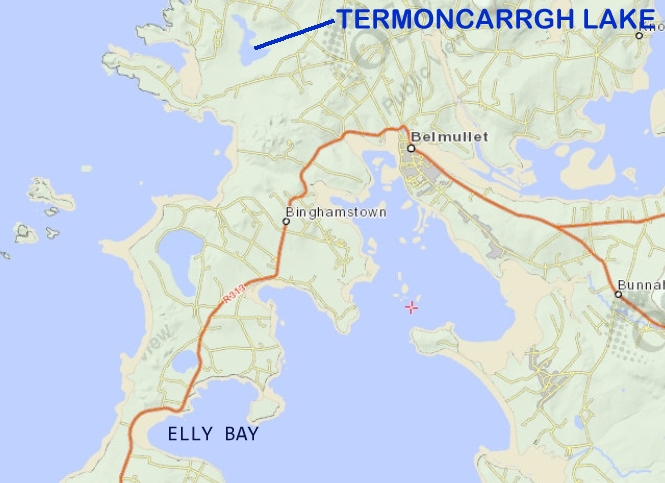
The crash of this aircraft is told from the official US Army Air Forces crash narrative, presented on the official Air Forces crash report. One can sense the rising danger that the crew found themselves over Ireland. This is brought home by the fact that only one month earlier a similar ferry flight of a Boeing B-17 had ended up crashing on the slopes of Tievebaun, Mount Truskmore in Sligo. The story of that crew is told here, Boeing B-17 Flying Fortress, 42-31420, Sligo. The investigation report for 42-97743 is presented below, although it is noted that this is not a signed narrative of events from Lt. Karr, but the results of other officer's investigation.
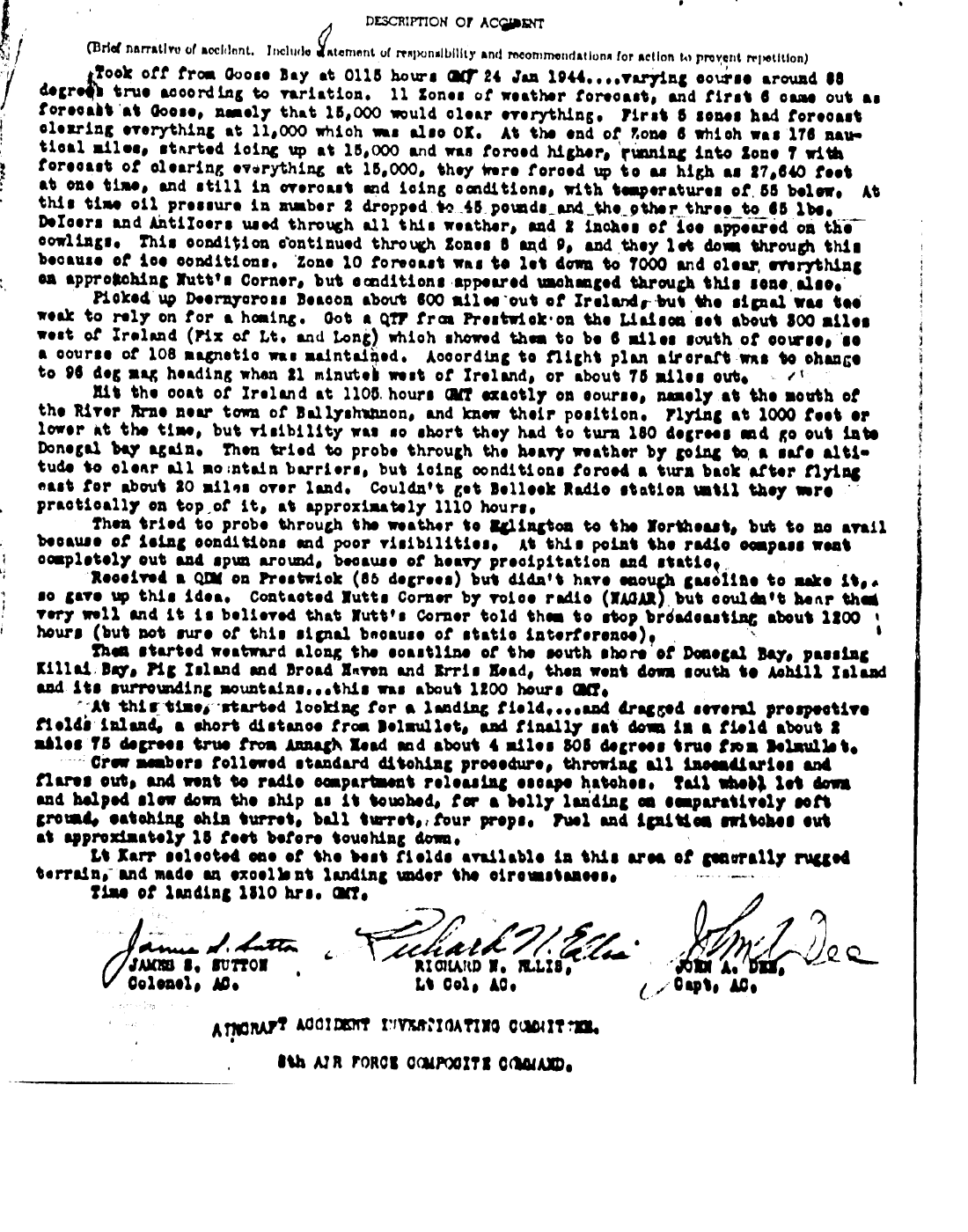
The immediate aftermath of the crash is taken up in Irish Army archive files. Martin Gleeson typed the following report for Morris Woodell from the aircrat's crew during the 1980's: Martin has given permission for this to be recorded on this page:
USAAF B-17 force-landing near
Belmullet, Co. Mayo on 24 January 1944.
The following details have been compiled from the
contemporary reports made out by the Irish Authorities. The
latter are now held in the Irish Defence Forces Military
Archives in Dublin.
The B-17 was first reported to the Irish Authorities
at c.13.00 hours (local time) on 24 January 1944 by the
Annagh Head Look-out Post (LOP) in County Mayo on the west
coast of Ireland. Later between 13.30 and 14.30 hours it was
seen circling near Annagh Head and Erris Head, before moving
inland.
The crew force-landed the B-17 wheels-up in a field
beside Termoncarragh Lake, 3 to 4 miles N.W. of Belmullet,
Co. Mayo at c.14.50 hours (or c.14.30 hours, actual landing
time is uncertain). The place where the landing occurred was
commonage, owned by the Land Commission (an agency of the
government). Damage to the aircraft was relatively light and
the crew were uninjured.
The Gardai (police) arrived about 35 minutes after the
landing. Five of the crew were taken to Healions Hotel in
Belmullet at 16.15 hours and the rest at about 19.00 hours.
All were accommodated in that hotel for the night. An army
guard from the 1st Infantry Battalion arrived on the scene
at c.20.00 hours, although at least one officer was there at
18.00 hours. Civilians and members of the Local Defence
Force (the Army Reserve) were probably first on the scene.
The crew gave as the reasons for the force-landing to
our Authorities bad weather conditions, that they were lost
and would have run out of fuel soon afterwards. The pilot
and one of the officers from the crew were allowed return to
the B-17 later that evening to "make some adjustments". What
these were are unclear: The American Legation in Dublin
contacted the crew that night.
The following day the crew were taken back to the
aircraft to retrieve their luggage, etc. The Royal Air Force
liaison officer, Flight Lieutenant Rory Moore, went with
them. After a meal in Belmullet that evening at 20.00 hours
they were taken northwards to the border with Northern
Ireland, arriving there at 01.30 hours on the 26th.
The aircraft itself was dismantled on site. Work began
on 25 January 1944 and involved at first members of the
Irish Air Corps. Later personnel from the RAF in Northern
Ireland came south with low-loaders to retrieve the B-17 in
sections. Three American technicians also assisted. These
were probably all civilian employees of the Lockheed
Overseas Corporation based at Langford Lodge in Northern
Ireland, one certainly was. However a tragedy occurred on
February 18th when one of the three died in a drowning
accident. George Kroushrop was washed out to sea while
photographing the nearby coast.
The final loads of
aircraft parts finally left the area on 3 March 1944 for
Northern Ireland.
The history of the 457th BG written by Ken Blakebrough records the departure to Europe as follows: "The planes took off on 20 January for the last leg of the flight to the British Isles from runways with six foot high snowbanks on either side of them. The flight across the Atlantic was by means of Dead reckoning. Crews had been warned that radio beam navigation was unreliable due to the possibility of "jamming" by German submarines. A cloud cover extended the entire length of the crossing, ten hours in time. Reaching the British Isles, some planes put down at Nutts Corners, Northern Ireland. Others landed at Valley, Wales and Prestwick, Scotland. Lts. Karr and Geiger both crashed in landing at Nutts Corners, but without serious injury to anyone, and during their unscheduled stopover in Ireland were introduced to Irish Potato Whiskey which all of them agreed had an excellent taste."
The author likely mixed up the two stories, the other pilot mentioned, Tracey E Geiger Jr., did have a landing accident at Nutts Corner and wrote off B-17 42-97459.
The crew of 42-97743, listed on the crash report and in Irish records was:
2/Lt Donald G. KARR O-803829, Pilot from Illinois.
2/Lt John E HAIGHT O-751731, Co-Pilot from Illinois
2/Lt Joel H. APEL O-681975, Navigator from
2/Lt Richard M. CONDON O-690372, Bombardier from Connecticut
S/Sgt Kenneth M. KRISE 33249569, Engineer from Pennsylvania
Sgt Phillip FINKELSTEIN 32496500, Waist Gunner from Bronx, New
York
S/Sgt Morris J. WOODELL 14188230, Radio Operator from North
Carolina
Sgt Paul M. ROGERS 39458458, Waist Gunner from Washington State
Sgt Charles L. EDWARDS 16052024, Ball turret Gunner from
Illinois
Sgt Eugene H. PAPROTA 32478767, Tail Gunner from Erie, New York
The crew was flying as part of the 749th Bombardment Squadron,
457th Bombardment Group (Heavy) on their deployment from the US.
The subsequent wartime career of the crew with the 457th Bomb
Group is told best on the website of the 457th BG Website ,
where there are photos of Donald Karr and his crew.
Their crew listings are presented here:
The
Donald Karr Crew (On 457th BG website)
The Donald Karr Crew (On 457th BG website).
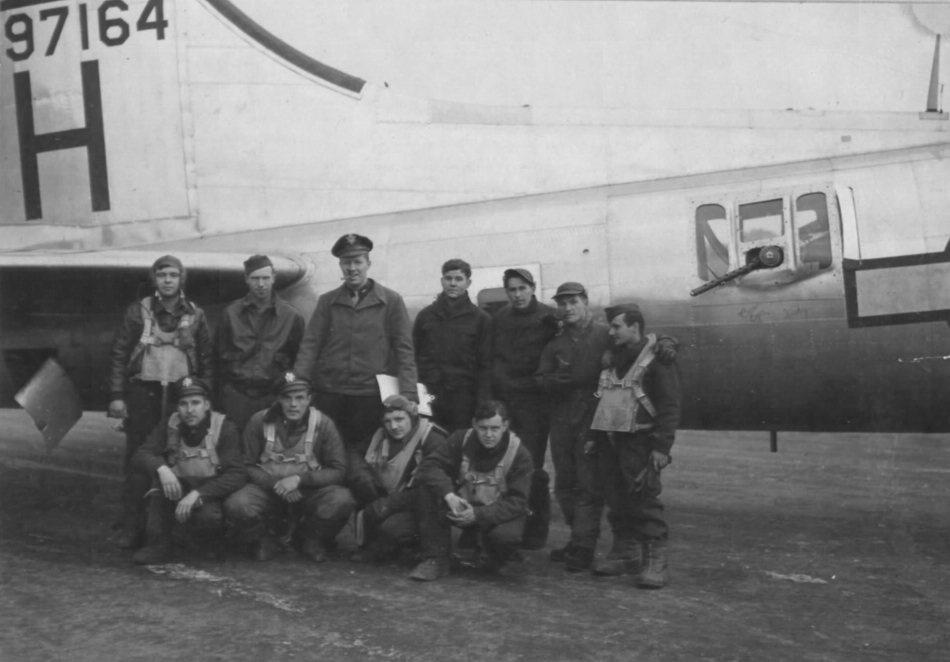
The Donald Karr Crew, photo taken 19 May 1944 (On the Fold3.com website, free database of USAAF photos). The 457th crew lists for this date show that the co-pilot was Lt Harry E Cameron. John Haight had been injured in April and had arrived in New York only two days before this picture was taken. There is an additional officer standing in this photo, center with the cigar.
The 457th BG flew formed in the US in July 1943. In January and February 1944, they were deploying as a Group to Europe to join the 8th Air Force. After their crash in Ireland, the first mission listed for this crew shows them flying to Augsburg, Germany on February 25th, 1944. On the 9th of April, 1944, Lt Carr's crew was forced to crash land their aircraft, a B-17 at the RAF base at Woodbridge. They had received a direct hit from flak in the cockpit area just after leaving the target, serverely injuring the Co-pilot Haight and temporarily blinding Lt Karr. The bombardier crawled from his position in the nose and with the aid of the upper gunner, took the place of Lt Haight at the controls and helped to steady the aircraft. As this was happening the aircraft had fallen well out of the main formation and had become a target for German fighters. After an undoubtedly long return flight, during which Lt Karr's vision returned, the two officers, with the determined efforts of the gunners, managed to get the aircraft back to the RAF station at Woodbridge. For his brave efforts on that day, 2/Lt Joel H Apel was awarded the Silver Star. The story is told on page 24 of the unit history on the 457th Website. John E Haight, as might be expected, does not appear on the mission rosters after this date. John's name is found on shipping records arriving at La Guardia Field, New York on a US Army Air Forces C-54 transport on the 17 May 1944. After this time, when the crew returned to combat, other members of the crew were replaced or moved to other crews, but they continued flying into 1945.
The removal of the large Boeing bomber from the ground in Belmullet required the involvement of Irish Army technicians as well as specialist recovery personnel from American bases in Northern Ireland. Among the personnel sent to the recovery site was a team of civilian technicians from the Lockheed Overseas Corporation (LOAC). This was a subsidiary organisation which performed certain maintenance and repair services for the US Government overseas. They were based in particular at Langford Lodge airfield outside Belfast. Among the team was 34 year old George Marshall Krouskop from Kittitas, Washington. George received mention in two of his local newspapers in 1943/44 about his wartime roles.
The Irish Army report on the salvage operation records simply
that an American technician named George 'Kroushop' was
swept off rocks near the crash site while on free time. He had
been taking photos and was in the company of a member of the
Irish army. Records suggest that his body was never recovered
from the sea, however he does have a death certificate issued by
the Irish General Register Office. This followed an
inquest held on the 27 September 1944.
Locals on social media recalled that the location of the
landing was on flat ground to the north west of Termoncarragh
Lake, on lands that were owned by an American Cable company
which had a telegraph cable running from Glebe House to North
America. There was excitement in the area for weeks after
as the dismantling progressed. Parts of the aircraft were
to be found all over the local area for years, sheets of
aluminum and pieces of structure filling gaps and fences.
The following photo is thought to have been taken during this
time, it was found on Facebook but has like many such photo's,
unclear source, its not clear who took it.
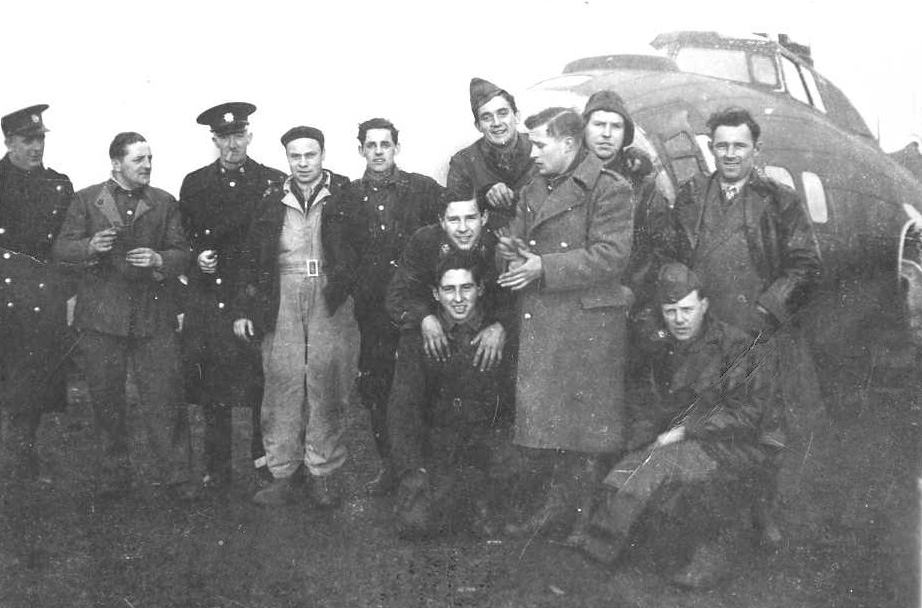
George was the son of Ernest and Blanch Krouskop. He was born
in Loveland, Colorado on 29 June 1909.
The US Army hold a file on George Krouskop among their
Individual Deceased Person Files (IDPF). This is a rather
functional collection of papers which deals with the authorities
efforts to return his personal effects to his mother. In one
letter to the Army asking about her sons effects, Blanche wrote
"He was with Lockheed Overseas Corps.
as crew chief, and was drowned on the day of Feb. 18, 1944,
and your office sent us a notice of his death".
The letters from his mother mention that an Irish soldier and
another LOAC mechanic were in George's company at the time of
his death. That other American is named as Leander R Krebs, a
Minnesota born man who died in Alaska in 1979.
She wrote later that: "Mr. Weaver had
cabled George twice to ask him to come home, that he needed
him badly at Boeing Air Plant, of which Mr. Weaver is Vice
President. Those cables were held up in Ireland and George
never saw them and knew nothing about it until Mr. Weaver
wrote him to know why he did not answer.
George was just about ready to come home, was in Belmullet
Co. Mayo, Eire, Ireland and had just finished superintending
the repair work on a bomber which was being delivered to
Lockheed and had crashed in Eire. George was to leave for
home the next week."
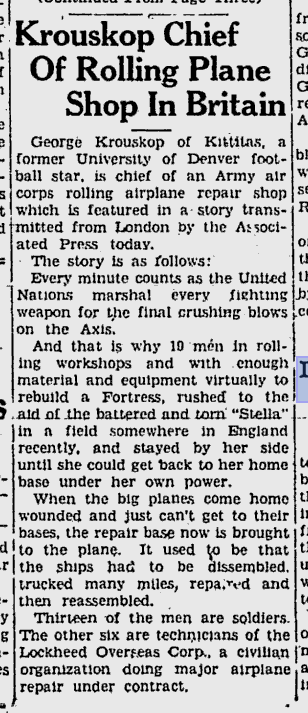 |
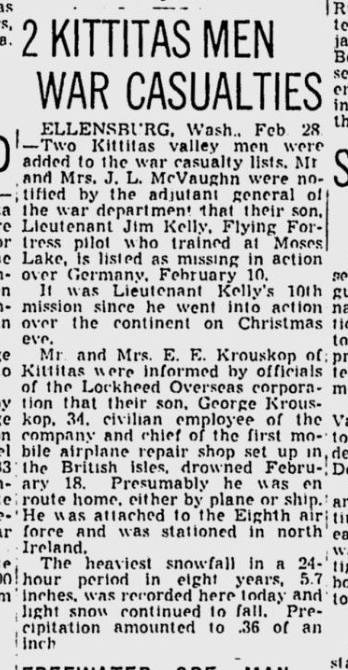 |
|
An article from the Ellensburg Daily Record telling the story of George's wartime career. |
An article from The Spokesman Review newspaper reporting the sad news of George's death. |
In 2007 I contacted the local community in Kittitas, Washington and some weeks later received emails and letters from George's nephew, John E Krouskop. Some very kind people from Kittitas remembered the Krouskop family and made contact with John in California. John sent on two photos containing George Krouskop in his days presumably with Lockheed Overseas Corporation. Sadly, John Krouskop died in 2009 before I could get confirmation of which of the men was George in the photo. These photos are presented below. In 2014 however, the nephew of George was able to confirm who George M Krouskop was in the photos.
|
John Krouskop said that both photos were annotated as 'mobile aircraft repair unit England 1943'. George Krouskop's nephew identified him as the man on the right hand side of the the first photo. He appears to also be the man behind the front row, at the right of the lower photo |
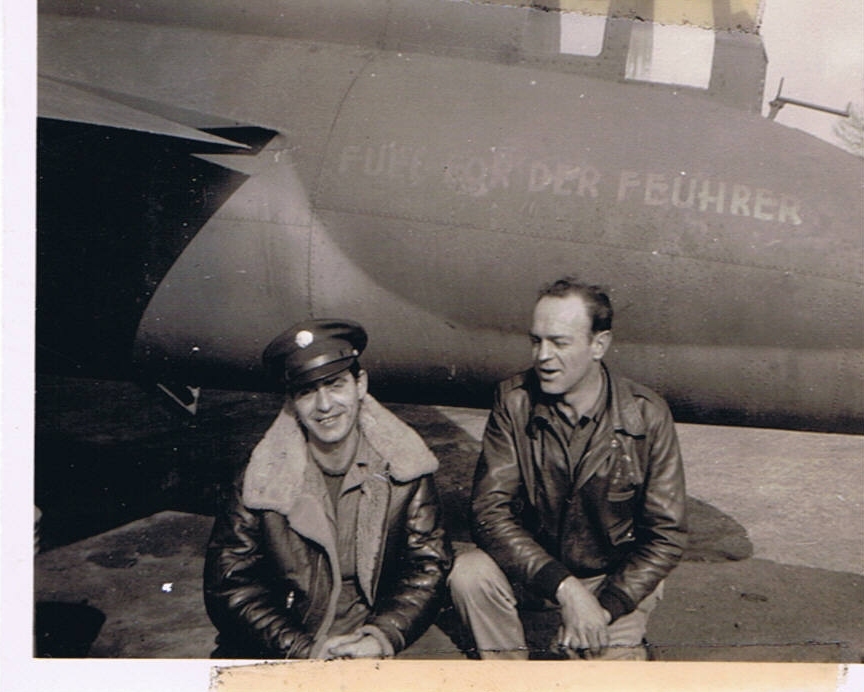 |
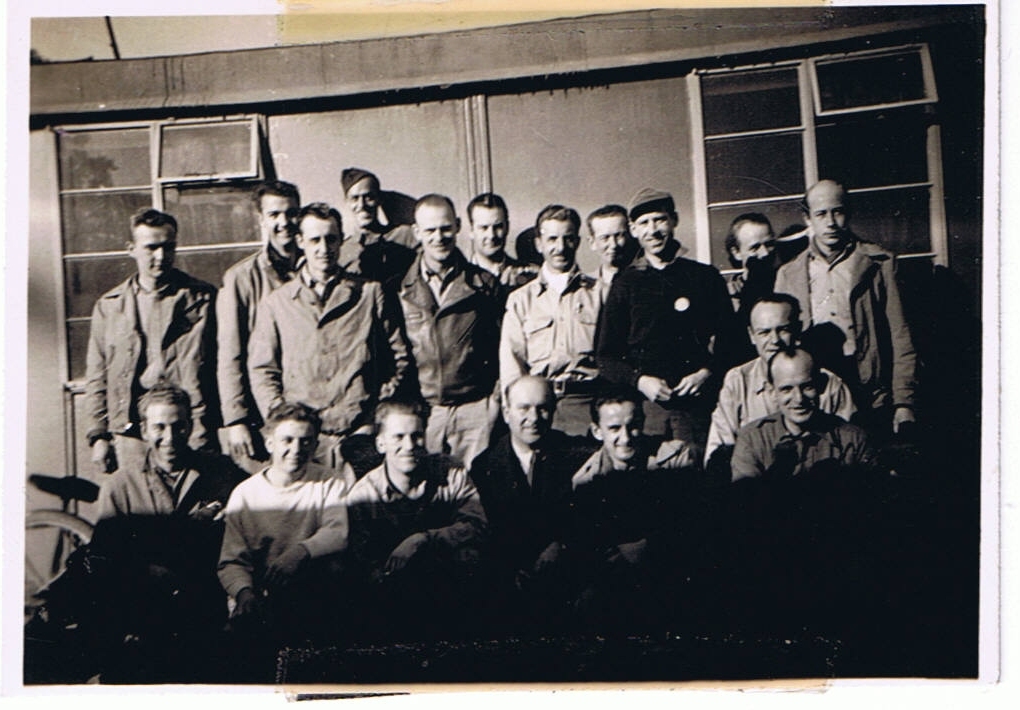 |
George's name is carved on a memorial stone in Loveland Burial
Park, Colorado, between the names of his sisters Isabel, who
died in 1922 and Sylvia, who died in August 1944.
And what of the crew of 42-97743, where did they end up after
the events described above?
2/Lt Donald G. KARR, Pilot from Wisconsin. Born in 1919
in Michigan to Ove L Karr, he was living in Rhinelander,
Wisconsin at the time of his enlistment in the summer of
1940. his local paper the Rhinelander Daily News covered
is wartime exploits. His career say his rise through the
ranks, from Corporal to Sergeant in January 1942, to Staff
Sergeant in February. He was at that time based at Maxwell
Field. It would be September that year when he was posted
to Maxwell Field as a flight training cadet. His brother,
Sgt Richard Karr, was reported to be a glider pilot.
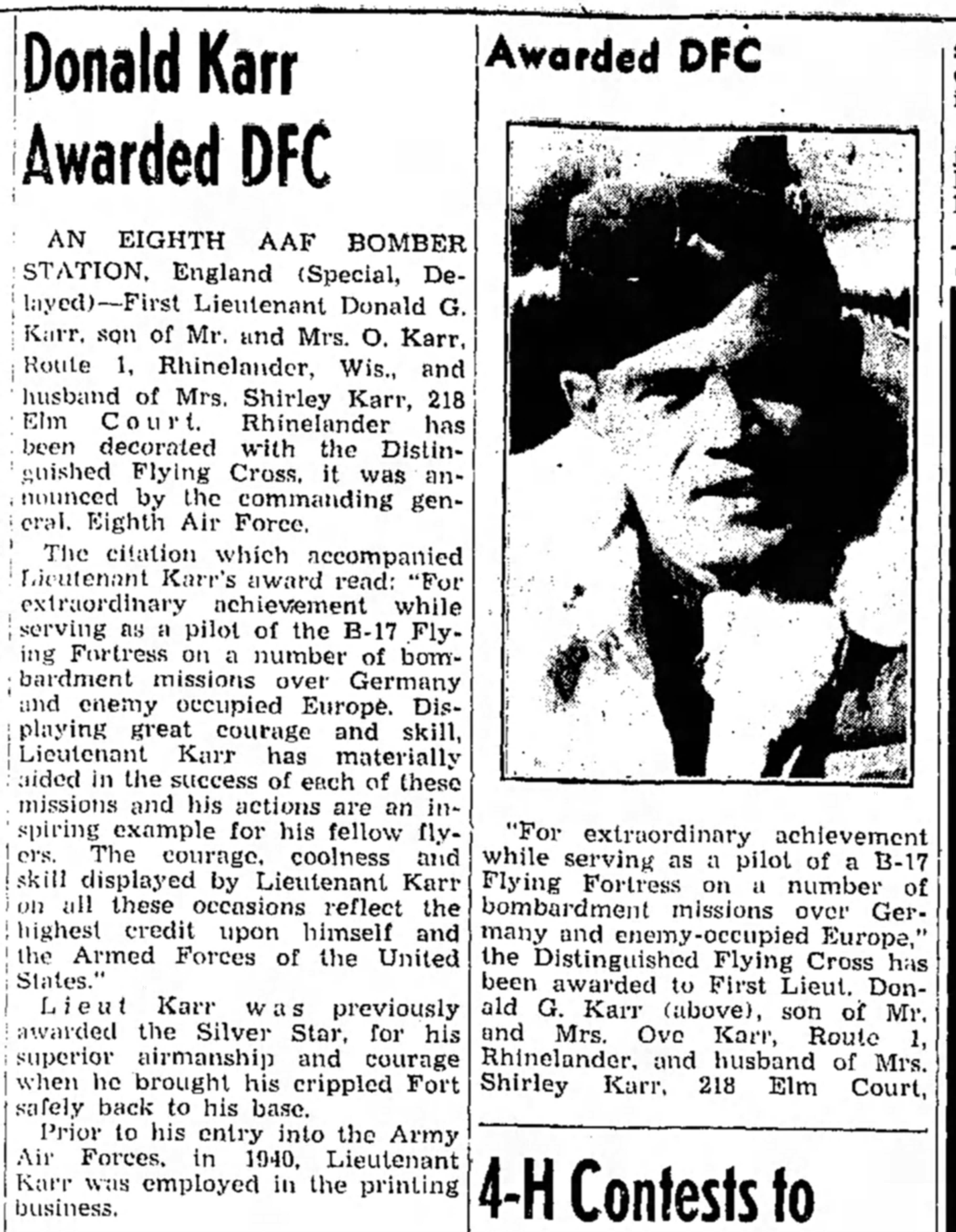
He returned to the USA in August 1944 on the SS Aquatania to
New York and were posted to Miami, Florida. In May 1945,
the Rhinelander paper reported on his having been awarded the
Caterpillar badge for a successful bail out from an
aircraft. Having flown into cloud and thunder storm, he
was forced to order his trainee crew to bail out. He
describes having to bail out as the aircraft broke up, then
landing in a tree, freeing himself from that only to land in
deep water and then swimming out until he met a civilian.
This report related to the loss of Boeing B-17G 42-102707 of the
328 Combat Crew Training Squadron on the 30th March 1945, out of
Gulfport Army Air Field in Mississippi.
The video below shows his 2014 flight in the B-17 of the
National Warplane Museum/1941 Historical Aircraft Group Museum
in New York.
-
Donald passed away in January 2015 and is buried in Canton, Georgia.
2/Lt John E HAIGHT O-751731, Co-Pilot from Galesburg,
Illinois. He was born in 1919.
John was awarded the Silver Star for his actions on the
February 1944 mission described above. His injuries would
see him return to New York on board an Air Transport Command
plane from Prestwick to La Guardia, New York on the 17 May
1944. He is written about in great detail in a book called
Gumption, A Grandmothers Story by
Constance Corcoran.
John passed away in 1992 in California at the age of 73.
2/Lt Joel H. APEL O-681975, Navigator. He was born
Joel Henry Apel in Michigan in 1918, and was residing in
Illinois at the time of his enlistment in 1942. Joel
continued his Air Force service after the war and served during
the Korean War. Joel served on B-29 heavy bombers. His
second period of service covered the years 1952 through to 1971.
Joel died in Texas in June 1998,
2/Lt Richard M. CONDON O-690372, Bombardier from 11
Waverly Avenue, Portland, Connecticut, was the son of Michael
and Ann Condon. In 1940 he is resident with his widowed
mother at their home in Portland. He registered for the
draft in February 1942 and a year later is named in local
newspapers as an Aviation Cadet on his way for training at
Nashville.
He passed away in September 2007 in Florida. He was employed at Travelers Insurance Co and retired an officer of the company after 40 years.
S/Sgt Kenneth M. KRISE 33249569, Engineer, from
Altoona, Pennsylvania. He continued to live in Altoona post war,
marrying and having three children. He died in 2016 in
Arizona.
Sgt Phillip FINKELSTEIN 32496500, Waist Gunner from Bronx, New York. It is thought that Philip lived until 2009 and died at the age of 98.
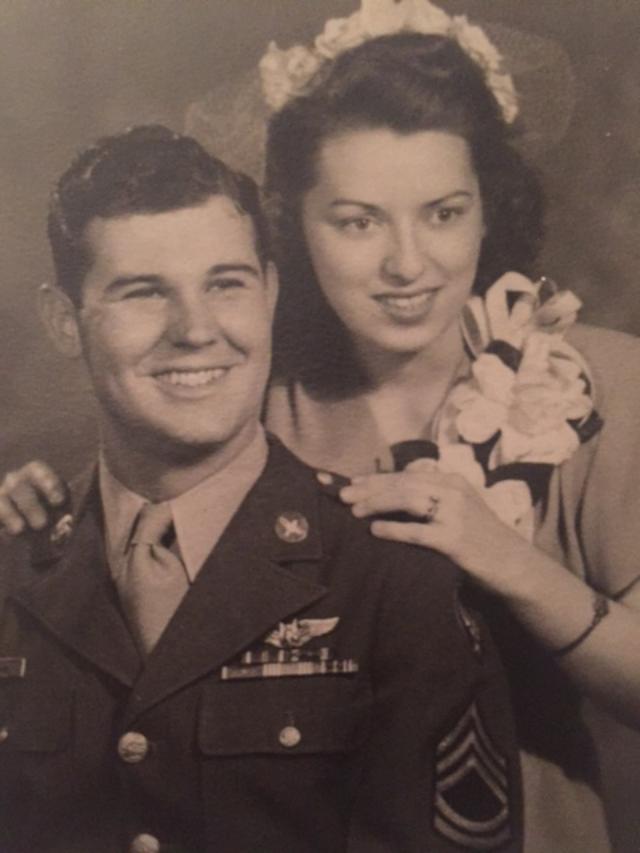 S/Sgt
Morris J. WOODELL 14188230, Radio Operator from North
Carolina passed away in April 2005 in his native North Carolina.
He submitted papers and a video interview to the Veterans
History Project at the Library of Congress. Among these
were the story that Martin Gleeson sent him and which is
presented above.
S/Sgt
Morris J. WOODELL 14188230, Radio Operator from North
Carolina passed away in April 2005 in his native North Carolina.
He submitted papers and a video interview to the Veterans
History Project at the Library of Congress. Among these
were the story that Martin Gleeson sent him and which is
presented above.
Morris, the son of Bennie and Nellie was born in High Point, North Carolina. Living in High Point, North Carolina, Morris enlisted in Winston-Salem in December 1942. In late 1944 he was awarded a DFC for his actions and this was reported in his local newspaper, the Greensboro Daily News:
High Point Boy Awarded Medal For
Air Combat
AN EIGHTH AAF BOMBER STATION ENGLAND. - Tech Sgt Morris
Woodell, son of Mr and Mrs Bennie A Woodell, 600 Fifth
street, High Point, N.C., has been decorated with the
Distinguished Flying Cross, it was announced by the
commanding general of the eighth air force. The citation
which accompanied Sergeant Woodell's decoration read: "For
extraordinary achievement while serving as a radio operator
- gunner of a B-17 Flying Fortress on a number of
bombardment missions over Germany and enemy occupied
Europe. Displaying great courage and skill, Sergeant
Woodell, fighting from his gun position has warded off many
enemy attacks and has materially aided in the success of
each of these missions. The courage, coolness and skill
displayed by Sergeant Woodell on all these occasions reflect
the highest credit upon himself and the armed forces of the
United States".
Prior to his entry into the Army Air Forces, Sergeant
Woodell was a student at the Allen Jay High school near High
Point. Mr and Mrs Woodell have another son, S/Sgt W. A.
Woodell who is also serving in the army air forces, at
present in North Carolina.
He returned home in September 1944, a month after 2/Lt Karr.
Sgt Paul M. ROGERS 39458458, Waist Gunner from
Washington State. Paul was born in 1920 to Emerson and Roxie
Rogers and lived in Okanogan County at the time of his
enlistment in 1942.
He passed away in May 1978 and is buried in Tonaset Cemetery,
Okanagan, Washington.
Sgt Charles L. EDWARDS 16052024, Ball turret Gunner
from Illinois, born on 26 November 1921.
Charles passed away in October 1991 and is buried in Quincy,
Illinois.
Sgt Eugene H. PAPROTA 32478767, Tail Gunner from Erie,
New York. Born in Buffalo, N.Y., Mr. Paprota lived in Harwood
Heights, Chicago for the past 40 years of his life and served on
the Harwood Heights Zoning Board of Appeals. During World War
II, he received an air medal with five clusters, the
Distinguished Flying Cross and a Purple Heart for a Berlin
mission. He was past commander of the Disabled American
Veterans. He passed away in 1990 in Illinois.
Compiled by Dennis Burke, 2024.
